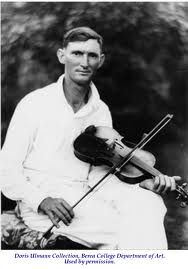Annotation:Indian Squaw (2): Difference between revisions
No edit summary |
m (Text replacement - "garamond, serif" to "sans-serif") |
||
| Line 1: | Line 1: | ||
=='''Back to [[{{BASEPAGENAME}}]]'''== | =='''Back to [[{{BASEPAGENAME}}]]'''== | ||
---- | ---- | ||
<p><font face=" | <p><font face="sans-serif" size="4"> | ||
'''INDIAN SQUAW [2]'''. Old-Time, Breakdown. G Major. GDad tuning (fiddle). AB. Some similarities to Alva Greene's version (see "[[Indian Squaw (1)]]"). Hiram Stamper's [http://www.berea.edu/hutchinslibrary/specialcollections/stamper.asp] (1883-1992) archaic version apparently was derived from a song. Stamper whistled to the 'B' part of the tune, and sang to the 'A' part: | '''INDIAN SQUAW [2]'''. Old-Time, Breakdown. G Major. GDad tuning (fiddle). AB. Some similarities to Alva Greene's version (see "[[Indian Squaw (1)]]"). Hiram Stamper's [http://www.berea.edu/hutchinslibrary/specialcollections/stamper.asp] (1883-1992) archaic version apparently was derived from a song. Stamper whistled to the 'B' part of the tune, and sang to the 'A' part: | ||
<blockquote> | <blockquote> | ||
| Line 13: | Line 13: | ||
<br> | <br> | ||
</font></p> | </font></p> | ||
<p><font face=" | <p><font face="sans-serif" size="4"> | ||
''Source for notated version'': Hiram Stamper (Hindman, Knott County, Ky., 1986) [Titon]. | ''Source for notated version'': Hiram Stamper (Hindman, Knott County, Ky., 1986) [Titon]. | ||
<br> | <br> | ||
<br> | <br> | ||
</font></p> | </font></p> | ||
<p><font face=" | <p><font face="sans-serif" size="4"> | ||
''Printed sources'': | ''Printed sources'': | ||
<br> | <br> | ||
<br> | <br> | ||
</font></p> | </font></p> | ||
<p><font face=" | <p><font face="sans-serif" size="4"> | ||
''Recorded sources'': <font color=teal>Titon (Old-Time Kentucky Fiddle Tunes), 2001; No. 69C, p. 99.</font> | ''Recorded sources'': <font color=teal>Titon (Old-Time Kentucky Fiddle Tunes), 2001; No. 69C, p. 99.</font> | ||
<br> | <br> | ||
<br> | <br> | ||
</font></p> | </font></p> | ||
<p><font face=" | <p><font face="sans-serif" size="4"> | ||
See also listing at:<br> | See also listing at:<br> | ||
Hear Stamper's 1986 field recording by Bob Butler at Berea Digital Content [http://cdm15131.contentdm.oclc.org/cdm/singleitem/collection/p15131coll4/id/9] and at Slippery Hill [https://www.slippery-hill.com/recording/indian-squaw-2]<br> | Hear Stamper's 1986 field recording by Bob Butler at Berea Digital Content [http://cdm15131.contentdm.oclc.org/cdm/singleitem/collection/p15131coll4/id/9] and at Slippery Hill [https://www.slippery-hill.com/recording/indian-squaw-2]<br> | ||
Revision as of 13:27, 6 May 2019
Back to Indian Squaw (2)
INDIAN SQUAW [2]. Old-Time, Breakdown. G Major. GDad tuning (fiddle). AB. Some similarities to Alva Greene's version (see "Indian Squaw (1)"). Hiram Stamper's [1] (1883-1992) archaic version apparently was derived from a song. Stamper whistled to the 'B' part of the tune, and sang to the 'A' part:
Way down yonder on the Arkansas,
Two old Indians and one old squaw,
Sitting on the banks of the Arkansas.
Jeff Titon (2001) finds nearly the same lyric in a song called "Bank of the Arkansas (The)" printed in Lomax and Lomax's Our Singing Country (1941, pp. 68-69), although Titon says tune that appears with that song is the same as that of Clyde Davenport's "Cornstalk Fiddle and a Shoestring Bow."

See also Missouri fiddler Bill Graves' "One Old Indian Two Old Squaws."
Source for notated version: Hiram Stamper (Hindman, Knott County, Ky., 1986) [Titon].
Printed sources:
Recorded sources: Titon (Old-Time Kentucky Fiddle Tunes), 2001; No. 69C, p. 99.
See also listing at:
Hear Stamper's 1986 field recording by Bob Butler at Berea Digital Content [2] and at Slippery Hill [3]
